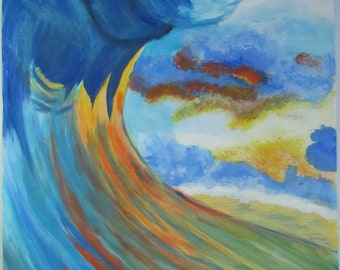

Although Hokusai designed the image, the blocks were made in the workshop of a master carver, commissioned by the publisher. The elemental power of the sea is expressed vividly in this dynamic image.ĭesigns such as this were carved into a set of cherry wood printing blocks and each design typically required five or six blocks (carved on both sides) to create the final print. Movement is accentuated by the swirling curves of the smaller waves and the boats. The immediacy of the scene creates a sense of looming catastrophe as the viewer imagines the subsequent moment as the wave crashes down. The claw-like froth on the wave appears menacing but the composition has been wittily arranged so that its foam seems almost to fall as snow onto the summit of the distant mountain. The potential destruction and action of the scene in the foreground contrasts with the serene stillness of the snow-clad mountain in the distance. These were rowed at great speed to transport fresh fish to market in Edo.

In this dramatic scene, Hokusai captures the moment just before a huge wave is about the crash down onto struggling boats beneath. In the series, the mountain is depicted from various viewpoints, in different weather conditions and compositions - sometimes dominating the image, other times, such as this, as a small but significant feature. Mount Fuji is the highest and most famous mountain in Japan and its elegant shape and monumental form has inspired religious and cultural veneration for centuries.
Colorful wave painting series#
The 'Thirty-six Views of Mount Fuji' series from which this print is taken, was made in his 'Iitsu' period, and were published from about 1829 to 1833, in his late sixties and early seventies. One of his names was 'Gakyojin' which translates as 'person mad with painting' which accurately reflects his prolific output. Hokusai took over thirty artist names during his long career. A wider variety of colours were also increasingly available.Ī common practice in Japanese artistic circles was for artists to take different names which often corresponded to different phases of style or subject-matter in their careers. He studied many styles of art in the city of Edo (modern Tokyo) in the late eighteenth century to develop his own particular idiom, at a time when aspects of European art, such as spatial recession, were being more widely used in Japanese print-making. Hokusai introduced landscapes to the genre and the 'Thirty-six views of Mount Fuji' series, from which this print is taken, was the first series made up exclusively of landscapes. These images were extremely popular from the late seventeenth to early twentieth centuries, and depict a beautiful and transient world, with subjects ranging from scenes of courtesans to portraits of actors. Hokusai was one of the leading painters and print artists of the nineteenth century, specialising in ukiyo-e images - meaning 'pictures of the floating world'. Printmaking has a long history in Japan and although Hokusai's image dates from the nineteenth century, it reflects centuries of development of the process. This image of a great wave about to crash down with a view of Mount Fuji in the distance is one of the most famous and widely reproduced Japanese prints. 293 & 294 Freer/Sackler Gallery, Hokusai, 2006, no. 11 Tokyo National Museum, Hokusai ten, 2005, nos. However, study to date suggests that this is probably one of the top twenty or so surviving impressions now known in the world.įurther comments, information and bibliographyĬlark, 100 Views of Mt Fuji, 1991, no. Many hundreds of impressions of the print have survived - attesting to its original popularity.

Fuji that seems to be unique among surviving impressions. There is a particularly beautiful woodgrain pattern in the dark sky either side of Mt. This is an early and fine impression, on thick paper. Since the later twentieth century the image has taken on international iconic status, widely adopted and adapted in advertising and popular culture. Many of the greatest impressions of the print that then found their way to Paris are now scattered in major museum collections, particularly in USA and back in Japan. Debussy's 'La Mer' is said to have been inspired by it.

Perhaps for this reason the print came very quickly to be celebrated among French collectors and artists, beginning in the late 1870s. The witty composition, whereby the highest mountain in Japan is apparently dwarfed by the 'Great Wave', marks a highpoint in Hokusai's creative processing of lessons of deep spatial perspective that ultimately derive from European art. The most famous Japanese print and one of the most famous graphic images in the world. For comprehensive discussion of this print design, see Timothy Clark, Hokusai's Great Wave (BMP, 2011)


 0 kommentar(er)
0 kommentar(er)
